Swedes Celebrate the 1915 World's Fair
San Francisco inaugurates the centennial of the 1915 World's Fair
-
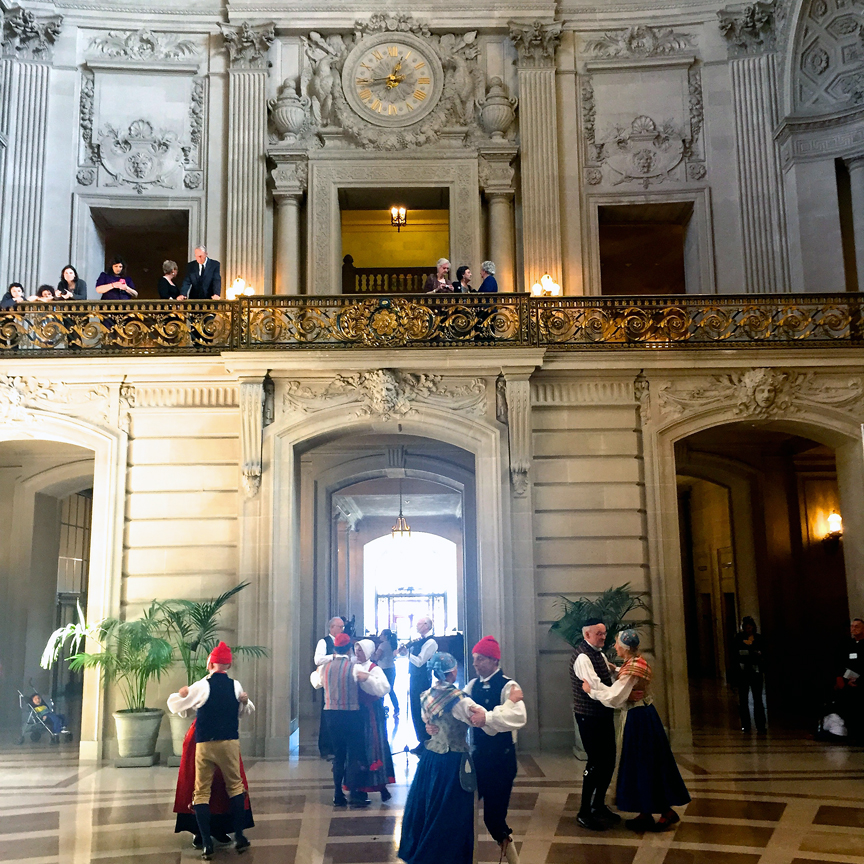 Swedes dance in City Hall Rotunda. Photo: Ted Olsson
Swedes dance in City Hall Rotunda. Photo: Ted Olsson -
-
Celebration of the centennial of the 1915 World’s Fair began early the week before the official opening when Chairman Scott Schulkin of Fylgia Lodge (VOA#119) produced one of the first events in the renovated Swedish American Hall. This was an event describing Swedish immigration to the San Francisco Bay Area from the Gold Rush of 1849 until 1915, presented by Sven-Ove Westberg and Carol Martin, who included the interesting tale of her immigrant Swedish family among the Sioux of North Dakota who became fluent in the language and the ways of these native American people.
The inauguration of the commemoration of San Francisco’s second of three world’s fairs — the Panama-Pacific International Exposition (PPIE) of 1915 — was held in the beautiful rotunda of San Francisco’s City Hall on February 20, 2015. Dance troupes initiated the celebration, with Swedish dancers from the Bay Area and Sweden. Gamelan Sekar Jayan with traditional Balinese (a province of Indonesia) dances and Margaret Jenkins Dance Company performed, too. Julie Mushet, producer of the dance event and director of World Arts West, introduced Sweden’s Consul General Barbro Osher, who remarked on how appropriate it was to bring together participants from Asia and Europe, just as the fair itself united the Old World here in the Wild West.
The Swedish dancers and musicians presented a suite of dances that mixed traditional couples’ dances from all over Sweden — Jämtland, Gästrikland, Hälsingland, Skåne and Dalarna — including hambos, polkas, polskas and schottises. Their precision was greatly admired, and rightly so after winning many dance competitions, including the largest folk dance competition and recognition in an event focused on Sweden’s oldest historical folk dance tradition. At the end, the local Swedish dancers joined them for a swirling dance and then members of the audience were invited to join in on the final hambo.
San Francisco’s legendary musician Carlos Santana, of Latin American rock fame, was born in Mexico to a Filipino father and a Swedish mother, from whom he learned the hambo. And there he was out on the dance floor. So, I confess that I couldn’t resist, and grabbed Astrid to join me on the palatial marble court-turned-dance floor. -
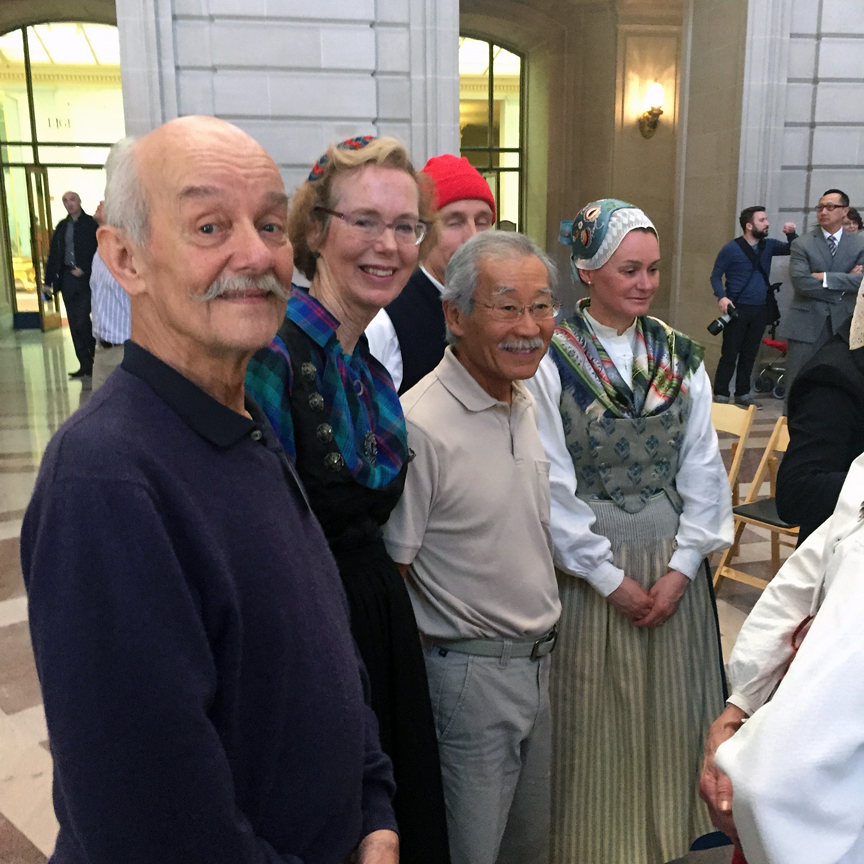 Carlos Satana, Brooke Babcock, Nobi Kurotori. Photo: Ted Olsson
Carlos Satana, Brooke Babcock, Nobi Kurotori. Photo: Ted Olsson -
-
Opening night gala recalls last century’s partying
The gala that night was spectacular as befits an occasion of this magnitude. The food was abundant, and the open bar celebrated the occasion with a Pink Palace martini. Men and women in period costumes from a century ago mixed with the crowd, and even Buffalo Bill Cody’s stand-in circulated about the cavernous arc of the thoroughly renovated Palace of Fine Arts, which — as a century ago — was suffused with amber lights, most fitting for this memento of a bygone era.
Inside held more nostalgia: the fire trucks that safeguarded the fair; the console of the magnificent Expo Organ (about which more is coming a separate article in this series); a Wells Fargo stage coach from the San Francisco bank that made its name delivering money and mail; and, much more.
After most of the guests had arrived, the Centennial’s executive director, Anthea Hartig, and San Francisco mayor, Edwin Lee, greeted everyone. Lee recalled the spirit of the mayor of 1915, Sunny Jim Rolf, who surely would have offered a hearty welcome to those assembled and to the 20 million yet to come during the next 10 months — upon the transcontinental telegraphic spark from President Wilson, Rolf opened the fair to a quarter of a million people on Opening Day alone. -
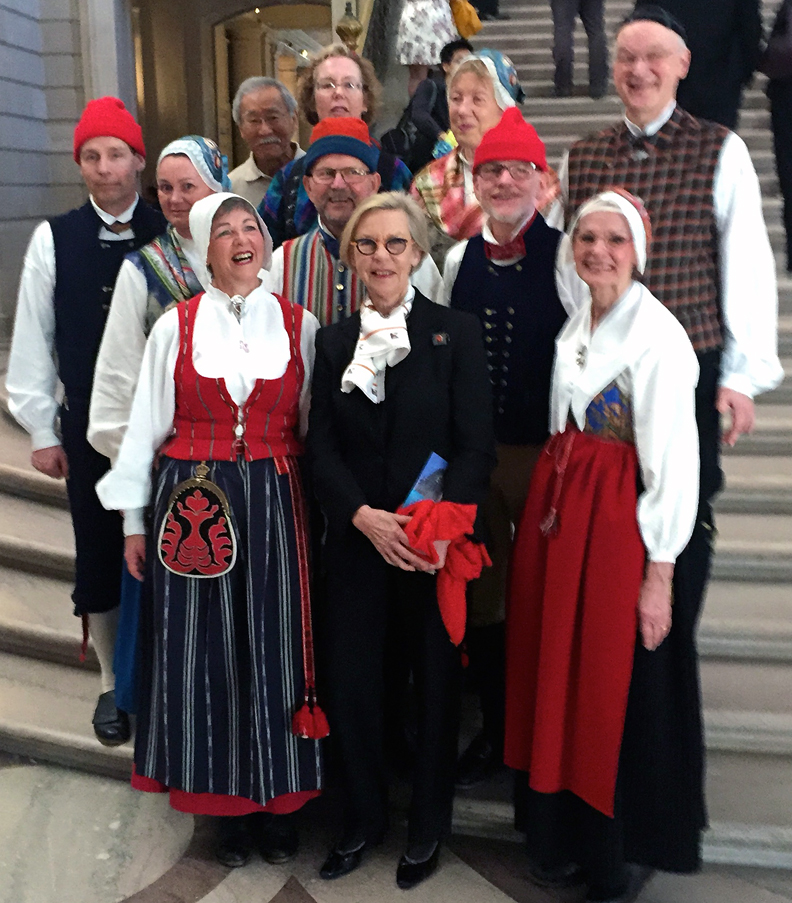 Swedish Dancers from Norberg, Sweden with Consul General Barbro Osher. Photo: Ted Olsson
Swedish Dancers from Norberg, Sweden with Consul General Barbro Osher. Photo: Ted Olsson -
A city that knows how
President Taft visited San Francisco three years after the earthquake and fire of 1906, and marveled at the resilience of the people, dubbing this “The City That Knows How!” A couple years later he signed the Act of Congress that designated the city as the host of the world’s fair, and he returned to symbolically break ground for the 1915 fair — though he did this in Golden Gate Park, the site of our first world’s fair, because the site for the second one was still contested.
Within nine years of the catastrophe of 1906 — which over three days burned 500 city blocks, destroyed over half a million dollars (the equivalent of more than $25 billion today) of property, killed several thousand people and left a quarter million homeless — San Francisco had built a city within a city, The Jewel City, on 635 acres, and would welcome the world. The exposition’s complex of palaces and pavilions is fondly remembered as one of the greatest of world’s fairs.
The very name “world’s fair” is strange today — perhaps replaced by Olympiads, bowl games and other international sports tournaments — but in its time it was both an expression of each country’s strengths and a vision of what the future could be. These international, competitive celebrations sporadically occurred for about two centuries.
San Francisco’s 1915 PPIE fair is fondly remembered, not merely with local nostalgia but for its coordinated and imposing design. Perhaps more than any other, this fair heralded transformative innovation. It not only fueled the rebirth of the city but it celebrated this city’s recurring theme of innovation and renovation and reinvention — as San Francisco continues to do today.
The Palace of Fine Arts
The second day of the anniversary celebration was declared Community Day at the Palace of Fine Arts (PFA), the sole building still on the site of the original fair grounds. Except for the expanse of Marina Green, Fort Mason on the Van Ness side and part of the fairgrounds in the Presidio, all of the remaining land of the fairgrounds has been filled in.
For the duration of the centennial, the PFA has become the target site to emphasize innovation of yesterday and today. It has teamed up with the Maker Movement to encourage children and people of all ages to experiment in tinkering and innovating with today’s latest technology and tools, including transistors and 3D printers.
Many historical and other non-profits with a tie to the commemoration were also there with all of the sponsoring and supporting organizations, but to me the most beautiful was a demonstration by TangoMango, a local dance studio. Tango is my favorite dance, and these masters of movement made everything look both suave and simple; elegance was mere nonchalance, it came so natural.
Toward the late afternoon there was an assemblage titled Ukethon, celebrating Hawaii’s introduction at the 1915 fair of its native instrument, the ukulele, which swept the nation with a craze for the instrument, the music, and, of course, the hula dance. Interesting to me was the fact that even the steel (slack-key) guitar was invented before this time and became part of the island band. Just hearing those soothing rhythms and music wafting across the lagoon from the PFA’s rotunda was enough to make one nostalgic for another time. -
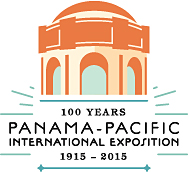 Panama Pacific International Exposition 100 years logo.
Panama Pacific International Exposition 100 years logo. -
Swedish immigrants encourage Sweden to participate
On Sunday, the third day, the Swedish American Patriotic League celebrated its return to the Swedish American Hall. It is still undergoing the finishing touches of renovation, but the league was grateful to be able to return to its home since 1907. This Founders Day program — dedicated to remembering all the past members of the community who have inspired us to pass on our revitalized community as our legacy to the next generation — focused on Swedes who had participated in the 1915 World’s Fair.
Historian Muriel Beroza reminded us of a simple story. With World War I overtaking Europe, Sweden was not keen on participating in a world’s fair half a world away. However, the local and regional patriotic Swedes were keen on it. They particularly wanted Sweden to participate because the king and kingdom had befriended the Swedish survivors of San Francisco’s devastation with a donation.
As part of San Francisco’s effort to gain the nation’s support for hosting this world’s fair, there were postcard-writing campaigns. Each San Franciscan was to write to at least three friends and relatives inviting them personally to come to the fair, and then asking those recipients to write to three more with the same message: Meet you at the fair. The Swedes did this chain letter one better: They asked their Swedish kinfolk across the U.S. to send donations large and small to ensure that their country would be properly included in the fair’s roll call of countries to host a pavilion.
It’s useful to remember that it took about six months for cargo to come from New York to San Francisco around the horn, unless a passenger cared to — dangerously — cut that time in half by trekking or riding burros across the Isthmus of Panama to catch a sailing ship on the other ocean.
San Francisco at the time was already one of the busiest ports in the United States. But the new Panama Canal halved transport time and made it important and easy to serve the U.S. along the whole west coast. Not only did San Francisco celebrate the opening of the canal for U.S. bicoastal trade but also for its role as a portal to Asia. Refreshing the ships and crew before their transpacific transit considerably opened and enhanced world trade for the entire U.S.
Consul General Matson, of San Francisco-Hawaiian shipping fame, had promoted Sweden’s participation in the fair, but it was the thousands of dollars that Sweden’s loyal emigrants had raised that made the kingdom reconsider participation in the fair. So, when the U.S. Commissioners Extraordinary visited the courts of Europe, Sweden agreed to participate and became the first foreign nation to choose a site and break ground for their pavilion.
Now the Swedish American Hall has benefited from a year of renovations, and visitors of the centennial celebration were treated to a tour of the upper portions of the hall. It was from this very hall that, in 1915, all the Swedes gathered in a caravan of cars and then drove in procession in the center of Scandinavian San Francisco to the fairgrounds. This hall and this fair were both milestones in the vitality of our community of Swedish San Franciscans, worthy of being remembered and celebrated. -
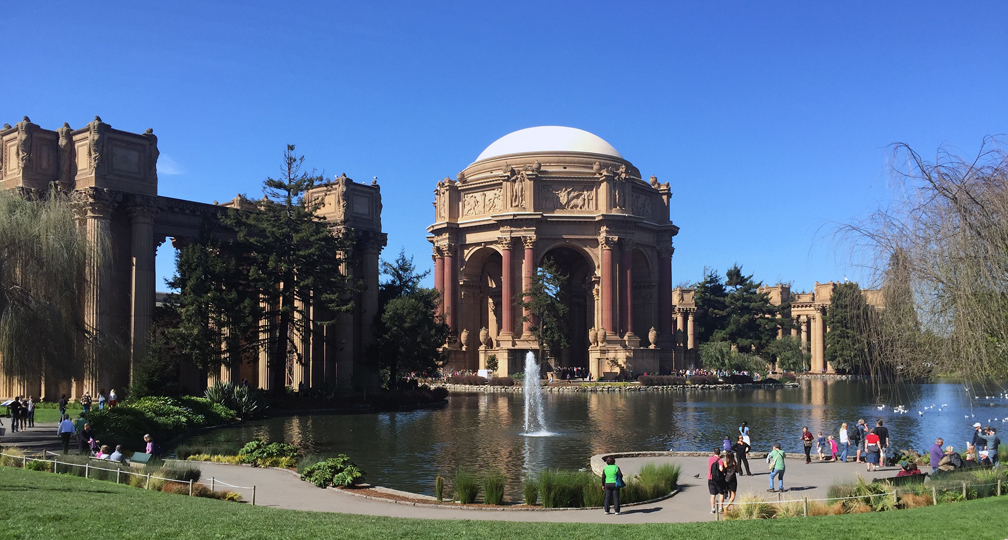 The Palace of Fine Arts in daylight. Photo: Ted Olsson
The Palace of Fine Arts in daylight. Photo: Ted Olsson -
By Ted Olsson
-
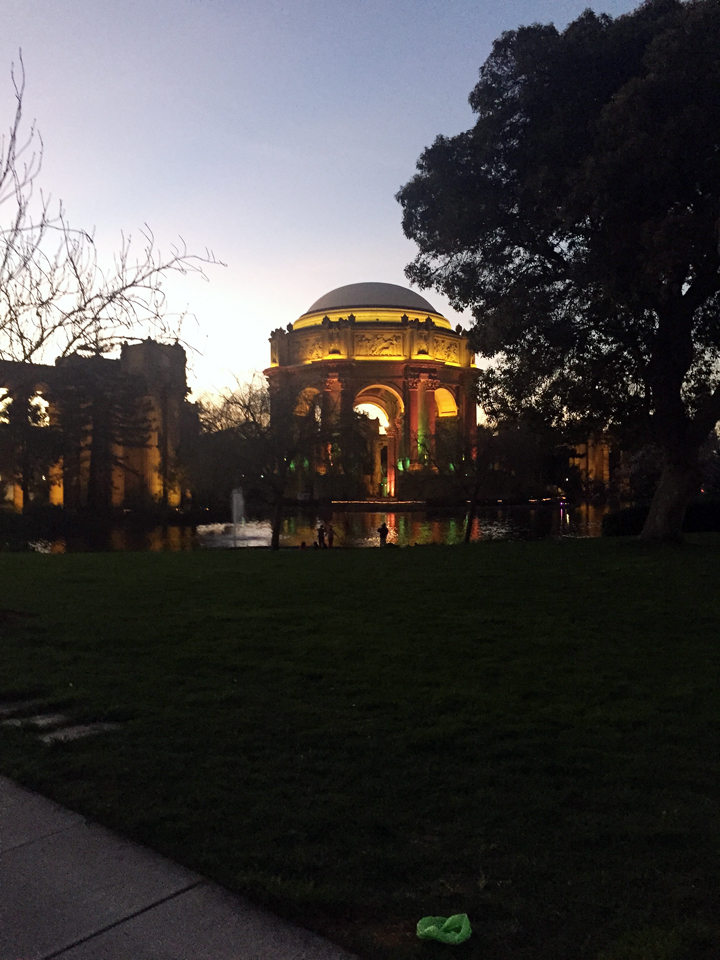 Palace of Fine Arts at dusk. Photo: Ted Olsson
Palace of Fine Arts at dusk. Photo: Ted Olsson -
For more info, see: http://www.ppie100.org
-
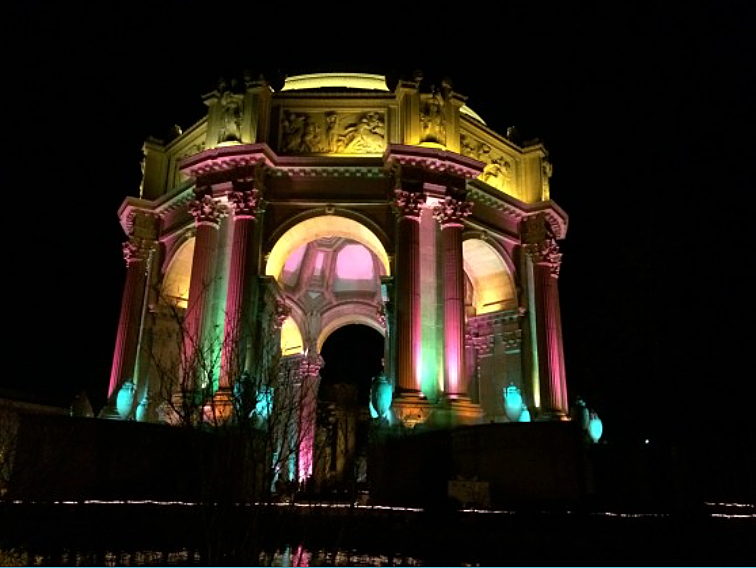 Palace of Fine Arts illuminated at night. Photo: PPIE100
Palace of Fine Arts illuminated at night. Photo: PPIE100 -
-
-
